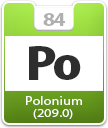Atomic Number of Polonium is 84.
Chemical symbol for Polonium is Po. Number of protons in Polonium is 84. Atomic weight of Polonium is 209 u or g/mol. Melting point of Polonium is 254 °C and its the boiling point is 962 °C.
Polonium = atomic mass = 218, atomic number = 84 (i looked periodic table). 1) Emits beta particle: Beta particle = atomic mass = 0, atomic number = -1. Po - beta + X. So, atomic mass X = 218. Atomic number X = 84 + 1 = 85. 2) Emits alpha particle: Alpha particle = atomic mass = 4, atomic number = 2. Po - alpha + Y. So, atomic mass Y. The atomic number of polonium is 84.The atomic number lead is 82.Which must occur for polonium to be transformed into lead? D.An atom of polonium must lose two protons The atomic number of lead is 82.Its mass number is 207.How many protons,neutrons,and electrons does this atom of lead contain? Plutonium is a radioactive chemical element with the symbol Pu and atomic number 94. It is an actinide metal of silvery-gray appearance that tarnishes when exposed to air, and forms a dull coating when oxidized. The element normally exhibits six allotropes and four oxidation states. It reacts with carbon, halogens, nitrogen, silicon, and hydrogen.
» Boiling Point» Melting Point» Abundant» State at STP» Discovery YearAbout Polonium
Polonium is the chemical element which was discovered by Marie Curie in the very end of the 19th century and named after her homeland, Poland. It is a very unstable radioactive metalloid, quite toxic and dangerous to all living organisms. It is very rare in nature and can be obtained from ores of uranium and bismuth. Polonium is used as a material for nuclear reactions as source of neutrons and heat, i.e. for space devices. It is also used for various scientific purposes.
Properties of Polonium Element
| Atomic Number (Z) | 84 |
|---|---|
| Atomic Symbol | Po |
| Group | 16 |
| Period | 6 |
| Atomic Weight | 209 u |
| Density | 9.32 g/cm3 |
| Melting Point (K) | 527 K |
| Melting Point (℃) | 254 °C |
| Boiling Point (K) | 1235 K |
| Boiling Point (℃) | 962 °C |
| Heat Capacity | |
| Abundance | 2×10−10 mg/kg |
| State at STP | Solid |
| Occurrence | Transient |
| Description | Metal |
| Electronegativity (Pauling) χ | 2 |
| Ionization Energy (eV) | 8.417 |
| Atomic Radius | 190pm |
| Covalent Radius | no datapm |
| Valence Electrons | 6 |
| Year of Discovery | 1898 |
| Discoverer | Marie and Pierre Curie |
What is the Boiling Point of Polonium?
Polonium boiling point is 962 °C. Boiling point of Polonium in Kelvin is 1235 K.
What is the Melting Point of Polonium?
Polonium melting point is 254 °C. Melting point of Polonium in Kelvin is 527 K.
How Abundant is Polonium?
Abundant value of Polonium is 2×10−10 mg/kg.
Polonium Dioxide Atomic Number

What is the State of Polonium at Standard Temperature and Pressure (STP)?
State of Polonium is Solid at standard temperature and pressure at 0℃ and one atmosphere pressure.
When was Polonium Discovered?
Polonium was discovered in 1898.
Overview
Polonium was discovered in 1898 by Polish-French physicist Marie Curie (1867-1934) and her husband, Pierre (1859-1906). They were looking for the source of radioactivity in a naturally occurring ore called pitchblende. Radioactivity is the process by which materials give off energy and change into new materials.
Polonium is the heaviest element in the chalcogen family. It is in Group 16 (VIA) on the periodic table. The periodic table is a chart that shows how chemical elements are related to one another. The other chalcogen elements are oxygen, sulfur, selenium, and tellurium.
SYMBOL
Po
ATOMIC NUMBER
84
ATOMIC MASS
208.9824
FAMILY
Group 16 (VIA)
Chalcogen
PRONUNCIATION
puh-LO-nee-um
Polonium is a relatively rare element. The pitchblende studied by the Curies contained only about 100 micrograms (millionths of a gram) of polonium per metric ton of ore. The element can now be prepared artificially in a particle accelerator, or 'atom smasher.' It causes small particles such as protons, to move at very high speeds. These speeds approach the speed of Light—300,000,000 meters per second (186,000 miles per second). The particles collide with targets, usually gold, copper, or tin. When struck by the particles, the targets break apart, forming new elements and other particles.
Polonium has a few commercial uses. For example, it is used to remove static electrical charges in certain industrial operations. The element is highly toxic.
Discovery and naming
In 1898 French physicist Antoine-Henri Becquerel (1852-1908) had discovered a new form of radiation that was similar to light rays. It was found in a uranium ore called pitchblende.
Becquerel's discovery encouraged many scientists to learn more about this radiation. Among these scientists were the Curies. They decided to study pitchblende to learn what was giving off radiation. They knew uranium was one source of the radiation, but the amount they found was too great to come from uranium only.
The Curies purchased pitchblende by the ton. They slowly purified the ore, getting rid of sand, clay, and other elements in the ore. After months of work, they finally isolated an element that had never been seen before. Marie Curie suggested the name polonium, in honor of her homeland, Poland. Polonium is hundreds of times more radioactive than uranium.
Physical properties
Polonium metal has a melting point of 254°C (489°F), a boiling point of 962°C (1,764°F), and a density of 9.4 grams per cubic centimeter.
Chemical properties
Litvinenko Poisoning
Polonium has chemical properties like the elements above it in the periodic table, especially selenium and tellurium. Polonium's chemical properties are of interest primarily to research chemists. Under most circumstances, scientists are more interested in polonium as a radioactive material.
Occurrence in nature
Polonium is produced in nature when other radioactive elements break down. It is so rare, however, that all the polonium needed is now made in particle accelerators.
Isotopes
Polonium has 27 isotopes, more than any other element. All of these isotopes are radioactive. Isotopes are two or more forms of an element. Isotopes differ from each other according to
A radioactive isotope is one that breaks apart and gives off some form of radiation. About the only isotope of any use is polonium-210.
Extraction
Polonium occurs so rarely and has so few uses that it is extracted from natural ores only for the purpose of research.
Uses
Polonium releases a great deal of energy during its radioactive breakdown. This has led to the development of compact heat sources for specialized purposes, such as use on space probes.
Radiation is used to remove static electricity from photographic film. Static electricity consists of electric charges that collect on the outside of a surface. In film, they can reduce the clarity of a picture. The radiation polonium releases creates electrical charges in the air around it. These charges combine with those on the film, neutralizing them and preventing damage to the film.
Compounds
There are no compounds of polonium of practical interest. Some polonium compounds are prepared for the purpose of research.
Health effects
Polonium is an extremely dangerous substance. When it breaks down, it gives off alpha particles. These particles are tiny, atom-sized particles that can destroy cells. Polonium is considered to be more than 100 billion times more dangerous than hydrogen cyanide. The maximum suggested exposure to the element is no more than about seven one-hundred-billionths of a gram.
Polonium is an extremely dangerous material. It has recently been found in the tobacco used in cigarettes.
A relatively new hazard of polonium has recently been identified. The element has been found in the tobacco used in cigarettes and other products. The amount of polonium taken in by a smoker is approximately equal to that taken in from all other sources. Polonium must be added, therefore, to the list of harmful chemicals inhaled during smoking.
